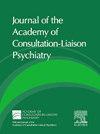脑状态监测频率功率比检测谵妄的有效性验证。
IF 2.5
4区 心理学
Q2 PSYCHIATRY
Journal of the Academy of Consultation-Liaison Psychiatry
Pub Date : 2025-07-01
DOI:10.1016/j.jaclp.2025.04.001
引用次数: 0
摘要
背景:住院患者的谵妄常常未被发现,并与住院时间和死亡率增加有关。脑状态监测仪(CSM)收集有限的导联脑电图(EEG)数据,在谵妄检测中显示出前景。目的:本研究比较了三种检测谵妄的方法:使用FDA批准的CSM的脑电图,3分钟诊断访谈的混乱评估方法(3D-CAM),以及传统的参考标准临床评估由精神病学咨询联络(CL)服务。方法:筛选经CL服务评估的住院患者,年龄为18岁。在适当情况下获得患者或授权代理人的同意。参与者通过3D-CAM进行筛选,随后放置4个额颞CSM导联,并在闭眼的情况下收集5分钟的脑电图数据。记录数据收集当天使用DSM 5标准进行精神病学评估时是否存在谵妄诊断。采用基于MAT LAB的头脑风暴(Brainstorm)程序计算脑电信号各频段的功率。结果:75例受试者中,58例具有完整的3D-CAM和EEG数据。23名参与者被临床诊断为精神错乱。3D-CAM区分谵妄和非谵妄参与者的灵敏度为65%,特异性为79%,曲线下面积(AUC)为0.720。神志不清和神志不清受试者的脑电功率在左颞部导联(L2导联)的高delta频段(FDR调整p = 0.020)和L2的低alphahighdelta频段比(FDR调整p = 0.039)上存在差异。在受试者操作曲线分析(ROC)上,低alphahighdelta和高delta的表现优于3D CAM,但并不显著(p均为0.18)。结论:CSM频带功率在谵妄和非谵妄患者之间存在显著差异,但作为谵妄的预测测试,其效果并不优于3D-CAM。本研究的优势包括使用FDA批准的CSM和免费提供的计算软件和方法。局限性包括样本量小,使得结果容易受到异常值的影响。未来的研究应该招募更大的样本量,并探索在床边与csm获得的联合脑电图变量的诊断效用。本文章由计算机程序翻译,如有差异,请以英文原文为准。
Validation of Cerebral State Monitor Frequency Power Ratios for Detection of Delirium
Background
Delirium among hospitalized patients often goes undetected and is associated with increased length of stay and mortality. Cerebral state monitors (CSMs) collect limited lead electroencephalography (EEG) data and have shown promise in delirium detection.
Objective
This study compares three methods of detecting delirium: EEG using an Food and Drug Administration-approved CSM, a 3-minute diagnostic interview for the Confusion Assessment Method (3D-CAM), and the traditional reference standard clinical evaluation by a psychiatric consultation-liaison service.
Methods
Hospitalized patients >18 years of age evaluated by the consultation-liaison service were screened for inclusion. Consent was obtained from either the patient or authorized surrogate when appropriate. Participants were screened with 3D-CAM, followed by placement of 4 frontotemporal CSM leads and collection of 5 minutes of EEG data with eyes closed. The presence or absence of a delirium diagnosis on psychiatric evaluation using Diagnostic and Statistical Manual-5 criteria the day of data collection was recorded. A MATLAB-based program (Brainstorm) was used to calculate power in each EEG frequency band.
Results
There were 75 participants, 58 with complete 3D-CAM and EEG data. Twenty-three participants were found to be delirious by clinical diagnosis. The 3D-CAM differentiated between delirious and nondelirious participants with a sensitivity of 65%, specificity of 79%, and area under the curve of 0.720. EEG power differed between delirious and nondelirious participants in the HighDelta frequency band in the left temporal (L2) lead (false discovery rate-adjusted P = 0.020) and the LowAlphaHighDelta frequency band ratio in L2 (false discovery rate-adjusted P = 0.039). On receiver operator curve analysis, LowAlphaHighDelta and HighDelta outperformed 3D CAM, although not significant (all P > 0.18).
Conclusions
CSM frequency band power differed significantly between delirious and nondelirious patients but did not outperform 3D-CAM as a predictive test of delirium. Strengths of this study include the use of an Food and Drug Administration-approved CSM and freely available computational software and methods. Limitations include a small sample size, making the results vulnerable to skewing by outliers. Future studies should recruit larger sample sizes and explore the diagnostic utility of combined EEG variables obtained with CSMs at the bedside.
求助全文
通过发布文献求助,成功后即可免费获取论文全文。
去求助
来源期刊

Journal of the Academy of Consultation-Liaison Psychiatry
Psychology-Clinical Psychology
CiteScore
5.80
自引率
13.00%
发文量
378
审稿时长
50 days
 求助内容:
求助内容: 应助结果提醒方式:
应助结果提醒方式:


